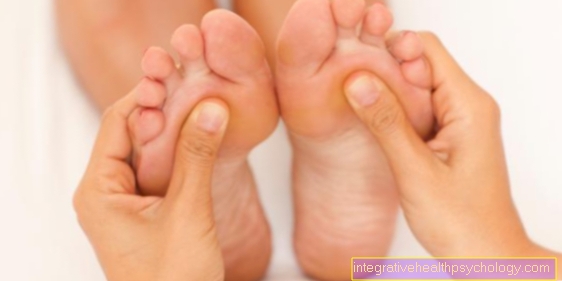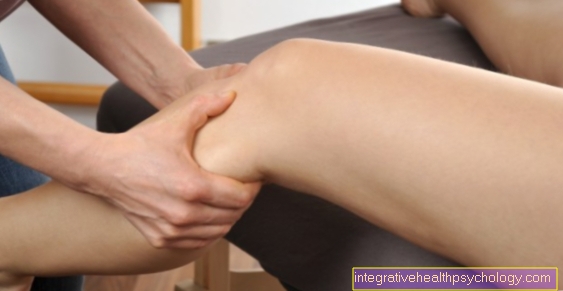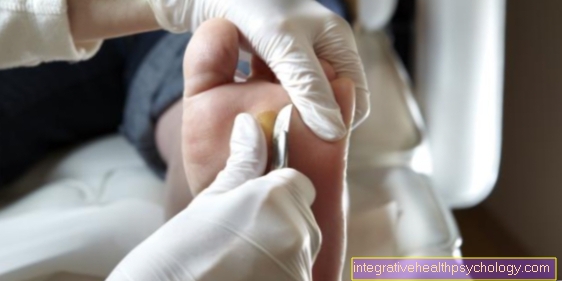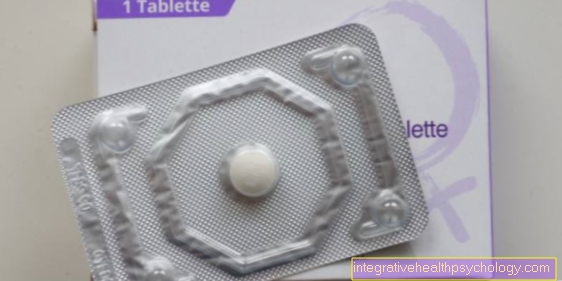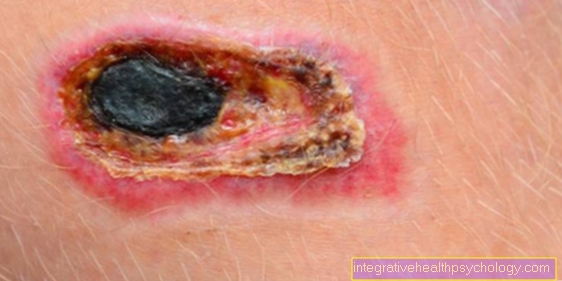Osteoarthritis attack
definition
In the context of osteoarthritis, which is a degenerative disease of the joints, pain is often not permanent, but rather shows an undulating course of the symptoms.
Phases of acute pain, so-called "relapses", alternate with symptom-free intervals that sometimes last for months.

How do you recognize an osteoarthritis attack?
A flare-up of osteoarthritis manifests itself through several quite typical symptoms, although it should be noted that these can present themselves significantly differently depending on the affected joint and individual predisposition. Symptoms can vary, especially with TMJ osteoarthritis. The typical symptoms of a flare-up include:
- Morning stiffness
- Start-up, movement and fatigue and pain at rest
- Joint effusion
- Redness and overheating
- Restriction of movement in the joint
A common sign of an osteoarthritis attack are morning stiffness and a so-called start-up pain; this means that the first movements after a period of rest are particularly painful and then the pain subsides again.
In other cases, the pain only becomes noticeable when moving, then referred to as so-called movement pain, or occurs after prolonged exertion as fatigue pain.
As the disease progresses, there is increasing pain at rest, which in turn means that patients can no longer sleep through the night due to pain. Due to the joint surfaces rubbing against each other, so-called crepitations, i.e. joint grinding, often occur.
Many patients also complain of muscle tension. The reason for this is a gentle posture, which is taken naturally due to the pain, but at the same time leads to the muscles being stressed in an unusual way and sometimes also overloaded. The body then reacts to this unusual strain by tensing the muscles and tendons.
An inflammation in the joint also leads to a joint effusion, which is particularly common in knee osteoarthritis (gonarthrosis). Patients notice a sometimes severe swelling of the joint. In some cases a so-called dancing kneecap (patella) can be observed. If there is a lot of fluid in the joint and you press on the kneecap with the knee extended and let go with a jerk, it “dances” up and down.
Other signs of inflammation may include reddening and overheating of the joint. Many patients report a restriction of the freedom of movement, in which gestures cannot be carried out to the end. On the one hand, this is pain-related and, on the other hand, the increasing changes in the bones, including the formation of cysts and bony outgrowths (osteophytes), ensure that the joint no longer functions properly.
Over time, the joint may even stiffen almost completely. The joint can also become increasingly unstable due to the ongoing damage to surrounding structures. The joint surfaces no longer fit together properly and, in addition, the physiologically stabilizing muscles and ligaments increasingly fail due to the inflammatory destruction.
Furthermore, people with osteoarthritis are sometimes sensitive to the weather. This means that the symptoms of an osteoarthritis attack particularly occur when the weather changes and in cold and wet conditions.
Arthrosis of the finger joints can lead to misalignments and deformities of the fingers due to remodeling processes.
Read more about the topic here: Activated osteoarthritis
Pain as a symptom
The main symptoms of an osteoarthritis attack include pain in the affected joint. These can develop at different speeds; some patients report a gradual increase in symptoms, while others report acute pain.
What they all have in common is that the pain mainly occurs when the joint is moved, and is often described as stabbing. The inflammation leads to increased blood flow to the joint, which can manifest itself as a throbbing pain component. As the inflammation subsides, the pain should subside as the healing process progresses.
More information on this topic: Symptoms of Osteoarthritis
causes
The causes of a flare-up of osteoarthritis have not yet been fully scientifically clarified.
However, various causes or underlying diseases are known that can lead to osteoarthritis, including cartilage-damaging events such as sports accidents and work-related overload or congenital joint malformations.
Overloading, injuries or misalignments of the joint seem to cause damage and, as a result, to increasing wear and tear of the cartilage. The thickness of the cartilage layer decreases over time until the bones rub directly against each other. The process of wear and tear also triggers inflammation that affects the entire joint and leads to further destruction of the joint.
The articular cartilage itself is not supplied by nerves, so the incipient abrasion initially goes unnoticed. Only when other parts of the joint, for example the periosteum, the synovial membrane or the muscles, are affected, does the patient begin to perceive pain.
A relapse is often followed by a pause for years until the pain recurs, which is also known as silent osteoarthritis. The symptom-free intervals then gradually get shorter and shorter and the symptoms get stronger.
Also learn more about the Causes of Osteoarthritis
What can be the trigger for an osteoarthritis attack?
An exact trigger for an osteoarthritis flare is usually difficult to determine. However, there are a few factors that can be the cause of an osteoarthritis attack. Sudden severe overloading of the joint can lead to an osteoarthritis flare-up.
Long-term stress or misalignments in the affected area can also contribute to the development of an osteoarthritis flare-up. The cartilage of the joint is damaged more and more. This damage to the tissue attracts immune cells, which are responsible for the development of inflammation.
It is still unclear whether infectious diseases, such as the flu, can also be partly responsible for osteoarthritis attacks.
Diagnosis
The diagnosis begins with a detailed anamnesis of the symptoms of an acute flare-up of osteoarthritis and a physical examination of the affected joint.
An x-ray is then often taken to rule out other diseases with similar symptoms. A narrowing of the joint space is already visible in the X-ray image in the early stages of the disease. Subchondral sclerotherapy follows. The doctor understands this to mean a radiologically visible compression of the bone beneath the cartilage layer, which appears whiter in the image than the surroundings.
In addition, osteophytes, i.e. bony attachments, and gaps in the bone that are filled with submerged tissue, connective tissue and fluid (rubble cysts) can be visible.
In addition, magnetic resonance tomography and arthroscopy can be used.
Please also read: Diagnosis of osteoarthritis
Appointment with ?

I would be happy to advise you!
Who am I?
My name is dr. Nicolas Gumpert. I am a specialist in orthopedics and the founder of .
Various television programs and print media report regularly about my work. On HR television you can see me every 6 weeks live on "Hallo Hessen".
But now enough is indicated ;-)
In order to be able to treat successfully in orthopedics, a thorough examination, diagnosis and a medical history are required.
In our very economic world in particular, there is too little time to thoroughly grasp the complex diseases of orthopedics and thus initiate targeted treatment.
I don't want to join the ranks of "quick knife pullers".
The aim of any treatment is treatment without surgery.
Which therapy achieves the best results in the long term can only be determined after looking at all of the information (Examination, X-ray, ultrasound, MRI, etc.) be assessed.
You will find me:
- Lumedis - orthopedic surgeons
Kaiserstrasse 14
60311 Frankfurt am Main
You can make an appointment here.
Unfortunately, it is currently only possible to make an appointment with private health insurers. I hope for your understanding!
For more information about myself, see Lumedis - Orthopedists.
How is an osteoarthritis flare treated?
The therapy for an osteoarthritis attack cannot be standardized and has to be designed individually. It should be noted, however, that osteoarthritis is still not curable today.
The aim is to reduce pain and restrictions and prevent consequential damage. Osteoarthritis patients have various therapy options available, although some measures are controversial in specialist circles. For the exact planning of a suitable therapy, those affected should consult a doctor.
One of the possible therapeutic measures is wearing a bandage. This can help relieve the pressure on the joints and in this way can alleviate stress-dependent pain in the course of an attack of arthritis.
A joint puncture, in which fluid is sucked out of the joint, can relieve pressure-induced pain and swelling-related movement restrictions.
Patients also use home remedies such as various types of joint wraps and heat applications to relieve an arthritis flare-up.
As part of drug therapy, so-called anti-inflammatory drugs, i.e. pain relievers, are used, as well as cortisone, which acts as an anti-inflammatory agent.
Read more on the topic: Therapy of osteoarthritis such as Proff® pain cream
Duration of an osteoarthritis attack
The duration of the osteoarthritis attack depends on the one hand on the severity of the underlying osteoarthritis, i.e. wear and tear on the joint, and on the other hand on the cause that triggered the osteoarthritis attack.
In the case of osteoarthritis in the early stage, in which the joint becomes inflamed, for example due to light stress, the flare-up of osteoarthritis can disappear after one or two days.
However, the duration of the osteoarthritis flare-up can be significantly lengthened if the osteoarthritis is in an advanced stage or if the osteoarthritis flare-up is based on a permanent deformity or overload of the joint.
In order to keep the duration of an osteoarthritis attack as short as possible, it is very important to relieve the joint as much as possible. Only simple movements with no additional weight should be performed. Elevating the affected body part can also be helpful. Furthermore, cooling shortens the duration of an osteoarthritis attack.
forecast
At first, osteoarthritis begins slowly and irregularly.
After an acute flare-up of osteoarthritis, months of symptom-free time often follow before another flare-up of osteoarthritis occurs. The pain-free intervals are getting shorter and shorter and the pain is getting worse. Increasing destruction of the joint occurs with extreme pain.
In the end-stage, patients report persistent pain that is no longer interrupted by pain-free episodes.
An already existing osteoarthritis cannot be reversed or cured so far.
Localization of the relapses
Osteoarthritis in the knee
If you suffer from osteoarthritis in the knee area, i.e. wear and tear on the knee joint, inflammatory activation of the osteoarthritis can occur again and again. This is also known as an osteoarthritis attack. Acute pain when moving the knee joint is usually the leading factor here. In addition, the typical signs of inflammation usually appear: reddening, swelling and overheating. These are caused by increased blood flow to the joint, which cells of our natural defense system lead to the inflammation.
A flare-up of osteoarthritis in the knee often leads to a significant restriction in movement and prevents e.g. a fast walking pace or climbing stairs.
Also read the article: Knee osteoarthritis.
Osteoarthritis flare-up in the finger
A flare-up of osteoarthritis of the finger manifests itself in the fact that movements in the affected joint become increasingly painful. A flare-up of osteoarthritis means that the joint in question, which was already suffering from osteoarthritis, has become infected.
When there is inflammation, the area is supplied with more blood in order to transport more cells of the immune system there. This makes the affected finger joint red and warm. Also, some fluid will leak out of the blood vessels and the area will swell. Due to pain and swelling, the joint can often no longer be moved and thus loses its function for the duration of the osteoarthritis attack.
Read more on the topic: Finger osteoarthritis
Osteoarthritis in the foot
The joints of the foot can also be affected by osteoarthritis. The metatarsophalangeal joint of the big toe is particularly often exposed to chronic wear and tear. Recurrent osteoarthritis attacks can also occur on the foot. The previously damaged joint becomes acutely inflamed.
Typical symptoms are severe pain when moving, as well as redness, swelling and overheating of the joint. The patients mostly suffer from severe mobility restrictions and may no longer be able to step on the foot.
Find out more about the topic here: Arthrosis of the big toe joint.
Osteoarthritis in the thumb
Osteoarthritis of the thumb saddle joint is very common and is also known as rhizarthrosis. The thumb joint is chronically heavily worn. Like any osteoarthritis, an osteoarthritis flare can also manifest in the thumb.
Typical for this are increasing pain when moving the thumb. The classic signs of inflammation also appear: swelling, reddening and overheating. These are inflammatory due to increased blood flow in the affected joint. The mobility in the thumb joint is therefore usually severely restricted by pain and swelling.
You can find more information on this topic here: Thumb saddle joint osteoarthritis.
Arthritis flare-up in the wrist
The wrist can also be affected by osteoarthritis due to chronic wear and tear. If there is an inflammatory reactivation of the osteoarthritis - also known as an osteoarthritis attack - the pain usually increases when the wrist is moved. Since the inflamed wrist is supplied with more blood, it also appears overheated, reddened and swollen.
A painful restriction of movement is typical.





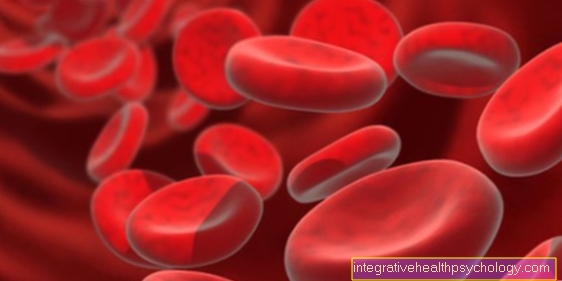



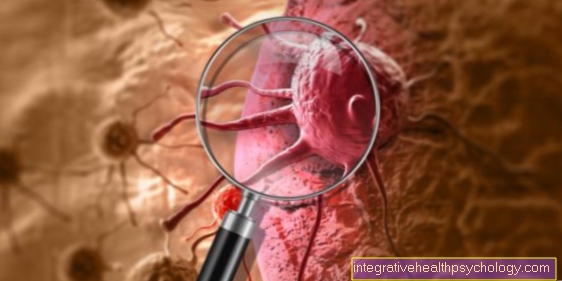



.jpg)
